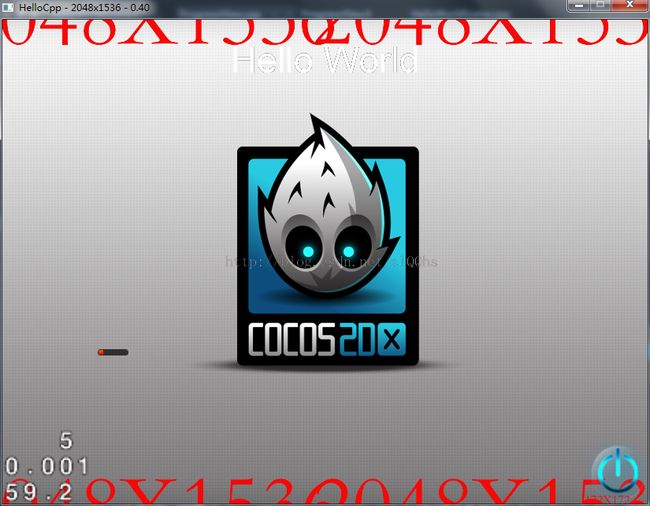Cocos2d-x--自定义血条
运行效果图:
资源图片:
血条前景图:
血条背景图:![]()
在HelloCpp项目中添加以下代码:
Progress.h:
#ifndef __PROGRESSVIEW_H__
#define __PROGRESSVIEW_H__
#include "cocos2d.h"
using namespace cocos2d;
class ProgressView : public CCNode
{
public:
ProgressView();
public:
void setBackgroundTexture(const char *pName);
void setForegroundTexture(const char *pName);
void setTotalProgress(float total);
void setCurrentProgress(float progress);
float getCurrentProgress() const;
float getTotalProgress() const;
private:
void setForegroundTextureRect(const CCRect &rect);
private:
CCSprite *m_progressBackground;
CCSprite *m_progressForeground;
float m_totalProgress;
float m_currentProgress;
float m_scale;
};
#endif
Progress.cpp:
#include "ProgressView.h"
void ProgressView::setBackgroundTexture( const char *pName )
{
m_progressBackground = CCSprite::create(pName);
this->addChild(m_progressBackground);
}
void ProgressView::setForegroundTexture( const char *pName )
{
m_progressForeground = CCSprite::create(pName);
m_progressForeground->setAnchorPoint(ccp(0.0f, 0.5f));
m_progressForeground->setPosition(ccp(-m_progressForeground->getContentSize().width * 0.5f, 0));
this->addChild(m_progressForeground);
}
void ProgressView::setTotalProgress( float total )
{
if (m_progressForeground == NULL) {return;}
m_scale = m_progressForeground->getContentSize().width / total;
m_totalProgress = total;
}
void ProgressView::setCurrentProgress( float progress )
{
if (m_progressForeground == NULL) {return;}
if (progress < 0.0f) {progress = 0.0f;}
if (progress > m_totalProgress) {progress = m_totalProgress;}
m_currentProgress = progress;
float rectWidth = progress * m_scale;
const CCPoint from = m_progressForeground->getTextureRect().origin;
const CCRect rect = CCRectMake(from.x, from.y, rectWidth, m_progressForeground->getContentSize().height);
setForegroundTextureRect(rect);
}
void ProgressView::setForegroundTextureRect( const CCRect &rect )
{
m_progressForeground->setTextureRect(rect);
}
ProgressView::ProgressView()
: m_progressBackground(NULL)
, m_progressForeground(NULL)
, m_totalProgress(0.0f)
, m_currentProgress(0.0f)
, m_scale(1.0f)
{}
float ProgressView::getCurrentProgress() const
{
return m_currentProgress;
}
float ProgressView::getTotalProgress() const
{
return m_totalProgress;
}
HelloScene.h:
#ifndef __HELLOWORLD_SCENE_H__
#define __HELLOWORLD_SCENE_H__
#include "cocos2d.h"
#include "ProgressView.h"
class HelloWorld : public cocos2d::CCLayer
{
public:
// Here's a difference. Method 'init' in cocos2d-x returns bool, instead of returning 'id' in cocos2d-iphone
virtual bool init();
// there's no 'id' in cpp, so we recommend returning the class instance pointer
static cocos2d::CCScene* scene();
// a selector callback
void menuCloseCallback(CCObject* pSender);
// implement the "static node()" method manually
CREATE_FUNC(HelloWorld);
private:
ProgressView *m_pProgressView;
};
#endif // __HELLOWORLD_SCENE_H__
HelloScene.cpp:
#include "HelloWorldScene.h"
#include "AppMacros.h"
USING_NS_CC;
CCScene* HelloWorld::scene()
{
// 'scene' is an autorelease object
CCScene *scene = CCScene::create();
// 'layer' is an autorelease object
HelloWorld *layer = HelloWorld::create();
// add layer as a child to scene
scene->addChild(layer);
// return the scene
return scene;
}
// on "init" you need to initialize your instance
bool HelloWorld::init()
{
//////////////////////////////
// 1. super init first
if ( !CCLayer::init() )
{
return false;
}
CCSize visibleSize = CCDirector::sharedDirector()->getVisibleSize();
CCPoint origin = CCDirector::sharedDirector()->getVisibleOrigin();
/////////////////////////////
// 2. add a menu item with "X" image, which is clicked to quit the program
// you may modify it.
// add a "close" icon to exit the progress. it's an autorelease object
CCMenuItemImage *pCloseItem = CCMenuItemImage::create(
"CloseNormal.png",
"CloseSelected.png",
this,
menu_selector(HelloWorld::menuCloseCallback));
pCloseItem->setPosition(ccp(origin.x + visibleSize.width - pCloseItem->getContentSize().width/2 ,
origin.y + pCloseItem->getContentSize().height/2));
// create menu, it's an autorelease object
CCMenu* pMenu = CCMenu::create(pCloseItem, NULL);
pMenu->setPosition(CCPointZero);
this->addChild(pMenu, 1);
/////////////////////////////
// 3. add your codes below...
// add a label shows "Hello World"
// create and initialize a label
CCLabelTTF* pLabel = CCLabelTTF::create("Hello World", "Arial", TITLE_FONT_SIZE);
// position the label on the center of the screen
pLabel->setPosition(ccp(origin.x + visibleSize.width/2,
origin.y + visibleSize.height - pLabel->getContentSize().height));
// add the label as a child to this layer
this->addChild(pLabel, 1);
// add "HelloWorld" splash screen"
CCSprite* pSprite = CCSprite::create("HelloWorld.png");
// position the sprite on the center of the screen
pSprite->setPosition(ccp(visibleSize.width/2 + origin.x, visibleSize.height/2 + origin.y));
// add the sprite as a child to this layer
this->addChild(pSprite, 0);
//初始化ProgressView
m_pProgressView = new ProgressView;
m_pProgressView->setPosition(ccp(100, 100));
m_pProgressView->setScale(2.2f);
m_pProgressView->setBackgroundTexture("background.png");
m_pProgressView->setForegroundTexture("foreground.png");
m_pProgressView->setTotalProgress(120.0f);
m_pProgressView->setCurrentProgress(22.0f);
this->addChild(m_pProgressView, 2);
return true;
}
void HelloWorld::menuCloseCallback(CCObject* pSender)
{
float progress = m_pProgressView->getCurrentProgress() + 12.0f;
m_pProgressView->setCurrentProgress(progress);
CCLOG("%f", m_pProgressView->getTotalProgress());
CCLOG("%f", m_pProgressView->getCurrentProgress());
}
